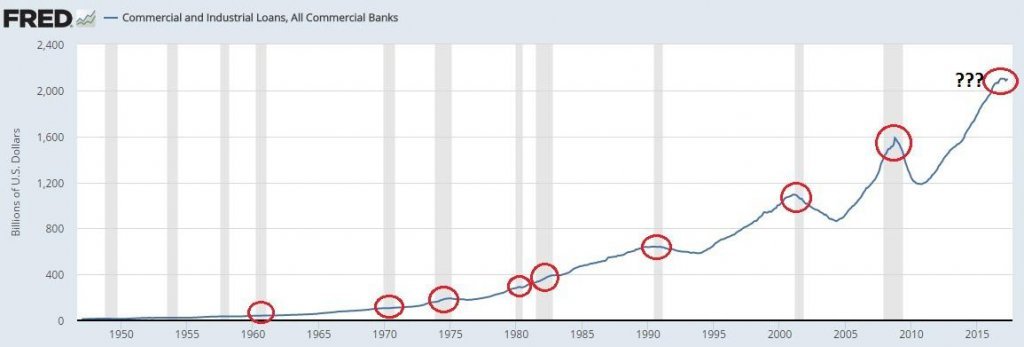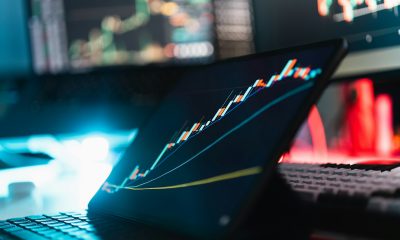Featured
These indicators say that a stock market crash is coming this year
As long as people invest, they will demand logical valuations and reasonable expectations of returns.

Slowly but surely, increasing signs of an upcoming stock market crash are showing. It’s not just this indicator or that indicator necessarily; it’s the cumulative effects of years of lackluster economic data. The signs are unmistakable, and serious investors are positioning their portfolios accordingly for a stock market crash 2017 possibly being on the doorstep.
The latest fly in the ointment relates to commercial bank Commercial and Industrial Loans (CIL) growth, which is showing signs of stagnation or going negative. This is a problem because, unlike other transitory data, slowing CIL growth has accurately predicted the last eight U.S. recessions since 1960. If current rates of deceleration hold, a recession could arrive within weeks. (Source: “U.S. Weeks Away From A Recession According To Latest Loan Data,” Zero Hedge, June 11, 2017.)
What makes CIL growth more predictive than rosy-looking U.S. employment or consumer price index (CPI) data? First, it’s not subject to the chicanery seen in U.S. employment data (revisionist birth/death guesstimates, for example) or CPI data (what really counts in inflation statistics anymore?). Second, it’s unadulterated confirmation that without constant credit expansion, the economy will implode. It’s painfully obvious to everyone at this point that lending growth, be it in the commercial or consumer side, must continue for the economy to keep growing. Not just here, but everywhere in the industrialized world. Even with this grease, the U.S. economic outlook 2017 has been stuck between comatose and crippled. Consumers have little ability to take on new debt. This has trickle-down effects on CIL, in which corporations have little incentive to invest in more production. They would rather use their access to cheap credit to buy back stocks rather than putting money to use in the real economy.
According to the chief equity strategist at Goldman Sachs Group Inc (NYSE:GS), David Kostin, corporate share buybacks will rise 30% in 2017 to $780.0 billion. This will account for the largest corporate allocation of free cash for only the second time in the last 20 years. (Source: “Share buybacks will rise 30% to $780 billion next year, says Goldman Sachs,” MarketWatch, November 22, 2016.)
There’s nothing wrong with returning value to shareholders, and stock buybacks are one effective means to accomplish this. But it’s also not the sort of lasting, sustainable foundation that the economy needs in order to grow long-term. It’s also a microcosm of what we’re seeing in the economy today. CIL is being herded into the wrong places because there are few productive places for CIL to expand. This happens to economies when capital costs are too low for too long. Persistently low-interest rates lead debts to increase to uncomfortable levels, and capital gets malinvested into all the wrong places, such as short-term credit facilities. A type of “zombification” of the economy takes hold, making organic growth somewhat impossible. Think Japan.
The upcoming recession will be about credit expansion grinding to a halt, plain and simple. It always happens at the end of the business cycle anyway, but loan demand is cratering more after each bust. CIL peak-to-trough demand dropped 9.12% during the 1990 recession; it dropped 21.14% during the Tech Bubble recession; and dropped 25.31% following the U.S. Housing Bubble recession. At what point can the Federal Reserve engineer a “soft landing” without crashing the dollar or destroying the U.S. Credit Rating, adding trillions of dollars that more quantitative easing would surely bring?(Source: “Commercial and Industrial Loans, All Commercial Banks,” Federal Reserve Bank of St. Louis, last accessed June 12, 2017.)

© Ibid.
This is the quandary that America faces today. Expand or die. And not just expand, grow at three percent-plus in perpetuity or keep falling behind at increasingly perilous clips.
A refusal to believe that a stock market correction is coming is to believe that this time it is different. The problem is, it’s never different. As long as people invest, they will demand logical valuations and reasonable expectations of returns. It may take longer than most anticipate, but fierce corrections always come. Barring a true hyperinflation or perpetual credit expansion (impossible), they simply have to.
Possible impacts of a stock market correction 2017
As a rule, the higher and longer a price expands, the greater the potential fall. Being that North American equity markets have appreciated more on a nominal basis than ever before, the next correction should be quite steep. Given this possibility, investors should pay particular attention to market history.
According to Kendrick Wakeman, CEO of FinMason, Inc., crashes happen every eight to 10 years, on average. The average drawdown during those periods is 42%. Also problematic is the fact that many investors have no idea about the concept of risk. Only 57% of polled investors understood what “risk tolerance” meant. (Source: “Investors clueless about impact of possible market correction,” CNBC, May 27, 2017).
This is problematic since the final phase of the U.S. Housing Bubble crash occurred in March 2009. Not only that; there hasn’t been a correction—defined as a 10% drop, peak-to-trough—since 2011. The market has literally been in an overbought condition for several years. Under such circumstances, stock market crash 2017 seems inevitable. It’s overdue.
Also problematic is the fact that many investors have no idea about the concept of risk. Only 57% of polled investors understood what “risk tolerance” meant. (Source: Ibid.)
Certainly, this ignorance has played a big part in the record amounts of exchange-traded fund (ETF) purchases. Investors across the globe purchased a record $131.0 billion in the first two months of 2017 alone. This follows a record-breaking year in 2016 when $390.0 billion in new cash was bestowed to ETFs. (Source: “Record-breaking 2017 for ETFs fuels fears of stock market bubble,” Financial Times, March 19, 2017.)
Investors appear to believe that the relative “stability” that ETFs employ will hold up, not realizing this may not happen if a stock market crash 2017 comes to pass. With everybody herded into one side of the boat, this could be a costly assumption.
Chief investment strategist of Clarity Financial Inc., Lance Roberts, believes that the torrent of investment capital into passively managed ETFs has left the market deeply unstable. He reasons that ETF over-purchasing has allowed weighted leaders to become over-invested, particularly in tech stocks, pushing up valuations all along the curve. (Source: “Lance Roberts: This Market Is Like A Tanker Of Gasoline,” PeakProsperity, May 30, 2017.)
In other words, too many people are unsuitably invested in names like Apple Inc. (NASDAQ:AAPL), Amazon.com, Inc. (NASDAQ:AMZN) and Netflix, Inc. (NASDAQ:NFLX). Should the panic selling ensue (and it will eventually), being in a “diversified” asset like an ETF will do little to cushion the fall. Roberts describes this market as “like a tanker of gasoline.” (Source: Ibid.)
The possible ramifications of a U.S. stock market correction 2017 cannot be understated under such conditions. In this interconnected world of tight correlations, combined with ETF herding and extreme overvaluation, a garden-variety correction could quickly turn into a cascade of selling. We’ve already witnessed several “flash crashes” throughout the years when algorithmic trading programs simply “turn off” when volatility gets too extreme.
Unlike the old days when human market makers had to provide liquidity on the way down, absorbing selling shocks along the way, algorithm programs are under no such obligation. When the wild selling comes, so will the extreme moves lower, which will likely trigger “circuit breakers” or forced exchange shutdowns for set periods of time. When they open back up, it’s anyone’s guess whether a suitable buy side bid re-emerges.
A substantial over-correction is one extreme, but it is a plausible risk that the market faces once meaningful selling takes place. All the ingredients are there: extreme overvaluation; top-heavy over-investment in select names (especially tech companies); record capital inflows at the peak (who’s left to buy?); and sideline cash allocation at business cycle lows, etc. There are literally too many reasons to do this topic justice.
The wall of worry turned into a mountain long ago. It will just take that loose pebble to trigger the mudslide.
What happens next?
Issuing a stock market forecast for the next three months is a difficult proposition. Attempting to time the market is next to impossible, assuming your inputs even come to pass. Even if they do, there’ no guarantee that the market will behave in a logical manner. This unending move higher in a declining earnings environment is a perfect testament of that.
However, it’s pretty certain that should a recession unfold, the market won’t be able to withstand the withering selling from all comers. It’s not like the market is cheap and flush with dip-buyers waiting to dive in. On the contrary, the over-invested class (which is basically everybody, institutional and retail) has an itchy finger, ready to press the big red button without much persuasion.
James Advantage Funds President Barry James said as much. In his stock market crash predictions 2017, he’s warning investors that risks are mounting and that a correction is inevitable. He thinks it’s just a matter of time before the big one hits. “Will the stock market crash, or deflate slowly?” is his biggest question. “We see this building towards perhaps some type of a correction in the stock market and we believe it’s time to sell,” said James. (Source: “With a possible correction looming in the stock market, ‘it’s time to sell,’ expert warns,” CNBC, June 6, 2017.)
Barry James joins the chorus of experts who believe the same thing. And while this alternative-minded author generally does not usually agree with the consensus, it’s hard to disagree. There’s no way I can reconcile the market maintaining a cyclically adjusted price-to-earnings (CAPE) ratio of around 30 (the third-highest ever) in a rising interest-rate environment during a recession. That’s a bridge too far.
—
DISCLAIMER: This article expresses my own ideas and opinions. Any information I have shared are from sources that I believe to be reliable and accurate. I did not receive any financial compensation in writing this post, nor do I own any shares in any company I’ve mentioned. I encourage any reader to do their own diligent research first before making any investment decisions.

-

 Africa1 week ago
Africa1 week agoMorocco Allocates 1.3 Billion Dirhams to Boost Startup Ecosystem Under Digital 2030 Strategy
-

 Crypto6 days ago
Crypto6 days agoAAVE Community Challenges Aave Labs Over Governance and Control
-

 Crypto2 weeks ago
Crypto2 weeks agoCrypto ETF Inflows Signal Renewed Market Confidence
-

 Crowdfunding2 days ago
Crowdfunding2 days agoDeep Learning Italia Launches €400K Crowdfunding to Bridge Italy’s Tech Skills Gap

























You must be logged in to post a comment Login